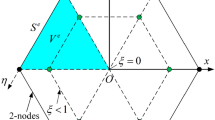Abstract
In this paper, a hybrid approach combining quantum-behaved particle swarm optimization (QPSO) and conjugate gradient method is proposed to identify boundary shape of the geometry under steady state conditions. No prior information about the shape is available, so the inverse problem is classified as function estimation. Least square method is used to model the inverse problem, which intends to minimize the difference between measured and calculated data. Considering ill-posedness of the inverse problem, Tikhonov regularization method is used to stabilize the solution. The numerical results show that the proposed hybrid method is able to recover the boundary shape, and can sharply reduce the required computation time. While considering the oscillations at the both boundaries of the estimated results, the parallel QPSO is used in order to both obtain better estimation and reduce computation time.










Similar content being viewed by others
References
Banks HT, Kojima F (1989) Boundary shape identification problems in two-dimensional domains related to thermal testing of materials. Quart J Appl Math 47:273–293
Pironneau O (1984) Optimal shape design for elliptic systems, New York
Sunahara Y, Kojima F (1986) Boundary identification for a two dimensional diffusion system under noisy observations. In: Proc. 4th IFAC symp. control of distributed parameter systems, UCLA, California, Pergamon Press, New York
Rondi L (1999) Optimal stability estimates for determination of defects by electrostatic measurements. Inverse Prob 15(5):1193–1212
Aparicio ND, Pidcock MK (1996) The boundary inverse problem for the Laplace equation in two dimensions. Inverse Prob 12(5):565–577
Beretta E, Vessella S (1998) Stable determination of boundaries from Cauchy data. SIAM J Math Anal 30(1):220–232
Hon YC, Wu Z (2000) A numerical computation for inverse boundary determination problem. Eng Anal Bound Elem 24(7):599–606
Nachaoui A (2003) An improved implementation of an iterative method in boundary identification problems. Numer Algorithms 33(1–4):381–398
Mera NS, Elliott L, Ingham DB (2004) Numerical solution of a boundary detection problem using genetic algorithm. Eng Anal Bound Elem 28(4):405–411
Dashti-Ardakani M, Khodadad M (2009) Identification of thermal conductivity and the shape of an inclusion using the boundary elements method and the particle swarm optimization algorithm. Inv Prob Sci Eng 17(7):855–870
Khodadad M, Dashi-Ardakani M (2008) Inclusion identification by inverse application of boundary element method, genetic algorithm and conjugate gradient method. Am J Appl Sci 5(9):1158–1166
Morozov VA (1966) On the solution of functional equations by the method of regularization [J]. Soviet Math Dokl 7:414–417
Hansen PC (2001) The L-curve and its use in the numerical treatment of inverse problems, computational inverse problem in electrocardiology. WIT Press, Holland, pp 119–142
Sun J, Feng B, Xu WB (2004) Particle swarm optimization with particles having quantum behaviour. Congress Evolutionary Computing, Portland
Sun J, Xu WB, Feng B (2004) A global search strategy of quantum-behaved particle swarm optimization, IEEE Conference on cybernetics and intelligent systems, Singapore
Sun J, Xu WB, Feng B (2005) Adaptive parameter control for quantum-behaved particle swarm optimization on individual level, IEEE international conference on systems, man and cybernetics, Hawaii
Kennedy J, Eberhart RC (1995) Particle swarm optimization, IEEE international conference neural networks, Perth, Australia
Ang KC (2008) Introducing the boundary element method with MATLAB. Int J Math Educ Sci Technol 39(4):505–519
Hunter P, Pullan A (2001) FEM/BEM notes. The University of Auckland, New Zealand
Kythe PK (1995) An introduction to boundary element methods. CRC Press, Boca Raton
Eberhart RC, Shi Y (1998) Comparison between genetic algorithm and particle swarm optimization. Evolutionary programming VII. Lecture notes in computer science, vol 1447. Springer Berlin, Heidelberg, pp 611–616
Clerc M, Kennedy J (2002) The particle swarm: explosion, stability, and convergence in a multi-dimensional complex space. IEEE Trans Evol Comput 6(1):58–73
Clerc M (1999) The swarm and the queen: towards a deterministic and adaptive particle swarm optimization. Congress on Evolutionary Computation, Washington D.C
Bratton D, Kennedy J (2007) Defining a standard for particle swarm optimization, IEEE swarm intelligence symposium, Honolulu, Hawaii
Van den Bergh F (2001) An analysis of particle swarm optimizers. Ph.D. diss., University of Pretoria, South Africa
Bourgeois L, Chaulet N, Haddar H (2012) On simultaneous identification of the shape and generalized impedance boundary condition in obstacle scattering. SIAM J Sci Comput 34(3):1824–1848
Bin-Mohsin B, Lesnic D (2012) Determination of inner boundaries in modified Helmholtz inverse geometric problems using the method of fundamental solutions. Math Comput Simul 82:1445–1458
Chauhan Pinkey, Pant Millie, Deep Kusum (2014) Parameter optimization of multi-pass turning using chaotic PSO. Int J Mach Learn Cybernet. doi:10.1007/s13042-013-0221-1
Tian Na, Lai Choi-Hong (2013) Parallel quantum-behaved particle swarm optimization. Int J Mach Learn Cybernet. doi:10.1007/s13042-013-0168-2
Ma W, Wang M, Zhu X (2013) Improved particle swarm optimization based approach for bilevel programming problem-an application on supply chain model. Int J Mach Learn Cybern. doi:10.1007/s13042-013-0167-3
Wang X, He Y, Dong L, Zhao H (2011) Particle swarm optimization for determining fuzzy measures from data. Inf Sci 181(19):4230–4252
Acknowledgments
This work is supported by the innovative research of Jiangnan University (Project Number: 1245210382130120, 1242050205142810), by National high technology research development plan project (Project Number: 2013AA040405).
Author information
Authors and Affiliations
Corresponding author
Rights and permissions
About this article
Cite this article
Tian, N., Zhu, L. & Lai, CH. Identification of boundary shape using a hybrid approach. Int. J. Mach. Learn. & Cyber. 6, 385–397 (2015). https://doi.org/10.1007/s13042-014-0266-9
Received:
Accepted:
Published:
Issue Date:
DOI: https://doi.org/10.1007/s13042-014-0266-9




